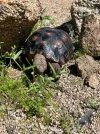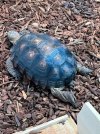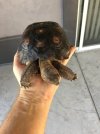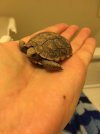MoreCowbellAz
Member
Meet Charlie. This was his 4th winter but it's the first time I brumated him, the previous 3 winters I kept him up and active.; the first couple years I wanted to be sure he was healthy (he was a rescue and in rough shape, see pic of tiny tortoise) and last year I was just plain scared and felt unprepared. But I put in all the research and we went for it this year, he's all re-emerged and is in full on active mode. I'm so happy it went just fine (but not without it's uncertainty and anxiety), so I wanted to share my experience, perhaps I can pay it forward to folks in the same position as me, lord knows this site was a god send.
First off, understand I am a worry wart by nature, so this first time was not easy for me. We had a pre-brumation vet check up, and got the thumbs up.
Anyway, my DT is primarily indoors at least for now although he does have an outside pen that he uses every day, but his nights and unsupervised time is all in a large enclosure I have for him inside my house. For brumation I used a beverage cooler which was nice because it has a glass front which makes it east to peek in without opening the door. I had a bunch of water bottles inside to (hopefully) stabilize them temps. I made a Velcro attached cover for the glass door (an old towel) to block light and keep it dark inside the fridge, and it’s easy to remove when I need to see inside. I started the fasting and cooling down process around Thanksgiving, and he started true brumation in the fridge 12/21. He was very active right up to the time I started his cool down and I found it difficult to avoid the temptation to feed him, I felt like I was depriving him, but I knew he needed to go a couple weeks with no food before winding down. He ended is brumation around 3/8.
He weighed 819g going in, 776g coming out, a 5% decrease. I don’t know if that’s about normal, but that’s what he was.
The biggest pain at the start was trying to drop the temp low enough prior to putting him into the fridge, I didn’t want a sudden and drastic temp change so somehow I needed to get him to about upper 50’s to around 60 before I could transfer him to the fridge. I never did find a great solution, I just let it get cold in my house for a few days and that worked fine, just not real fun. I’ll figure out something better for next year.
His actual brumation box was a plastic box with his normal orchid bark inside, I put him in that a couple days before the fridge. When I first put him in the fridge I had him covered with an inch or so of substrate, but he eventually uncovered himself and stayed on top the rest of the way. I let him be. I thought he’d want to be buried but apparently not the case. Another lesson.
I had a lid on the box with a lot of ¼’ holes drilled in it. I also has a remote temp sensor actually inside the box right next to him, so I always knew what the true temp was right inside his box, regardless of the temp in other parts of the fridge. I had another thermometer elsewhere inside the fridge just in case.
Once in the fridge I kept the temps in the 46-51 range for the most part, sometimes it would vary a degree or so from that if the room temp changed, funny how that affects the fridge temp. That was one of the many discoveries for me. At this temp range the tort was pretty much still throughout brumation, but it didn’t take much increasing at the end before he starting moving around. Not scratching or anything, but shifting positions or moving a few inches one direction or another.
With the remote sensor inside the brumation box, I was able to monitor temps pretty much constantly since I work from home. I logged everything so next year I won’t have nearly so many unknowns.
I didn’t pull him out at all during brumation. The most intrusive thing I did was I noticed the humidity was getting a little high at one point so I put in a couple rice bags (rice in an old sock) and that stabilized it, the humidity was in the 40’s – high 50’s for the most part. Weird, cuz it’s really dry here. Another lesson.
I know I probably didn’t need to, but I did open the fridge door every few days and “fanned” in some fresh air. I just couldn’t get past being paranoid about him not getting enough air, or the air somehow being stale, or even the plastic inside gassing some fumes. Anyway that’s what I did, and it never disturbed him. I always did it at night so it was dark and cool and it caused no temp change in his box.
I was going for about 12 weeks of brumation, after about week 11 of brumation I started to nudge up the fridge temp a degree or so a day, thinking it would be several days before he noticed anything changed. Not so, it only took a couple degrees before he started shifting around a little. I didn’t want him to become so active inside that he started clawing, that would make me feel bad, so I took him out after a couple days and let him stay in his cool enclosure with no light or heat. The transition seemed about right to me. He was definitely active, walking around in his enclosure the very next morning at the crack of dawn, looking for basking. He drank that day, got a soak, and a day after that he ate a fair amount, I was surprised. He was definitely hungry.
Then here’s the weirdest thing, once he ate that day, his appetite pretty much went away for close to a week. He remained active (but lazy and slow moving) and drank and soaked every day, good light and heat, all looked normal, but zero interest in food no matter what I tried. And he seemed a little out of it. I was really starting to stress about the not eating, I thought all my carefully executed plans were failing. Then all of a sudden one day he flipped the switch and became as active as ever, all his normal behaviors (liking his shell rubbed, etc), and a major appetite. It was like turning on a light bulb, not a gradual progression. Crazy. Apparently even though he was “up” it still took time for him to really snap out of it. I expected a more linear and predictable transition, but not so. Good to remember for next time, cuz that was the single most stressful and scary time out of the whole thing, I thought somehow I did something wrong, even though I was VERY careful to follow the process. Anyway, big lesson there.
That was about a week and a half ago, and since then he’s active and healthy by all appearances. He’s loving our outdoor spring weeds here (was a wet winter). Also over the winter I enlarged his enclosure a revamped his lighting and hides, a side benefit of brumation and having some extra time.
I never would have figured out half of this stuff without the fine folks on this forum. The advice I’ve gotten saved me an untold amount of mental anxiety, and certainly resulted in a healthy DT in his first brumation.
Enjoy the pics. Most are recent except for the one where he’s obviously small and rough looking, that was the day I found him in a subdivision retention basin.
Mark




First off, understand I am a worry wart by nature, so this first time was not easy for me. We had a pre-brumation vet check up, and got the thumbs up.
Anyway, my DT is primarily indoors at least for now although he does have an outside pen that he uses every day, but his nights and unsupervised time is all in a large enclosure I have for him inside my house. For brumation I used a beverage cooler which was nice because it has a glass front which makes it east to peek in without opening the door. I had a bunch of water bottles inside to (hopefully) stabilize them temps. I made a Velcro attached cover for the glass door (an old towel) to block light and keep it dark inside the fridge, and it’s easy to remove when I need to see inside. I started the fasting and cooling down process around Thanksgiving, and he started true brumation in the fridge 12/21. He was very active right up to the time I started his cool down and I found it difficult to avoid the temptation to feed him, I felt like I was depriving him, but I knew he needed to go a couple weeks with no food before winding down. He ended is brumation around 3/8.
He weighed 819g going in, 776g coming out, a 5% decrease. I don’t know if that’s about normal, but that’s what he was.
The biggest pain at the start was trying to drop the temp low enough prior to putting him into the fridge, I didn’t want a sudden and drastic temp change so somehow I needed to get him to about upper 50’s to around 60 before I could transfer him to the fridge. I never did find a great solution, I just let it get cold in my house for a few days and that worked fine, just not real fun. I’ll figure out something better for next year.
His actual brumation box was a plastic box with his normal orchid bark inside, I put him in that a couple days before the fridge. When I first put him in the fridge I had him covered with an inch or so of substrate, but he eventually uncovered himself and stayed on top the rest of the way. I let him be. I thought he’d want to be buried but apparently not the case. Another lesson.
I had a lid on the box with a lot of ¼’ holes drilled in it. I also has a remote temp sensor actually inside the box right next to him, so I always knew what the true temp was right inside his box, regardless of the temp in other parts of the fridge. I had another thermometer elsewhere inside the fridge just in case.
Once in the fridge I kept the temps in the 46-51 range for the most part, sometimes it would vary a degree or so from that if the room temp changed, funny how that affects the fridge temp. That was one of the many discoveries for me. At this temp range the tort was pretty much still throughout brumation, but it didn’t take much increasing at the end before he starting moving around. Not scratching or anything, but shifting positions or moving a few inches one direction or another.
With the remote sensor inside the brumation box, I was able to monitor temps pretty much constantly since I work from home. I logged everything so next year I won’t have nearly so many unknowns.
I didn’t pull him out at all during brumation. The most intrusive thing I did was I noticed the humidity was getting a little high at one point so I put in a couple rice bags (rice in an old sock) and that stabilized it, the humidity was in the 40’s – high 50’s for the most part. Weird, cuz it’s really dry here. Another lesson.
I know I probably didn’t need to, but I did open the fridge door every few days and “fanned” in some fresh air. I just couldn’t get past being paranoid about him not getting enough air, or the air somehow being stale, or even the plastic inside gassing some fumes. Anyway that’s what I did, and it never disturbed him. I always did it at night so it was dark and cool and it caused no temp change in his box.
I was going for about 12 weeks of brumation, after about week 11 of brumation I started to nudge up the fridge temp a degree or so a day, thinking it would be several days before he noticed anything changed. Not so, it only took a couple degrees before he started shifting around a little. I didn’t want him to become so active inside that he started clawing, that would make me feel bad, so I took him out after a couple days and let him stay in his cool enclosure with no light or heat. The transition seemed about right to me. He was definitely active, walking around in his enclosure the very next morning at the crack of dawn, looking for basking. He drank that day, got a soak, and a day after that he ate a fair amount, I was surprised. He was definitely hungry.
Then here’s the weirdest thing, once he ate that day, his appetite pretty much went away for close to a week. He remained active (but lazy and slow moving) and drank and soaked every day, good light and heat, all looked normal, but zero interest in food no matter what I tried. And he seemed a little out of it. I was really starting to stress about the not eating, I thought all my carefully executed plans were failing. Then all of a sudden one day he flipped the switch and became as active as ever, all his normal behaviors (liking his shell rubbed, etc), and a major appetite. It was like turning on a light bulb, not a gradual progression. Crazy. Apparently even though he was “up” it still took time for him to really snap out of it. I expected a more linear and predictable transition, but not so. Good to remember for next time, cuz that was the single most stressful and scary time out of the whole thing, I thought somehow I did something wrong, even though I was VERY careful to follow the process. Anyway, big lesson there.
That was about a week and a half ago, and since then he’s active and healthy by all appearances. He’s loving our outdoor spring weeds here (was a wet winter). Also over the winter I enlarged his enclosure a revamped his lighting and hides, a side benefit of brumation and having some extra time.
I never would have figured out half of this stuff without the fine folks on this forum. The advice I’ve gotten saved me an untold amount of mental anxiety, and certainly resulted in a healthy DT in his first brumation.
Enjoy the pics. Most are recent except for the one where he’s obviously small and rough looking, that was the day I found him in a subdivision retention basin.
Mark




